Canon LV-7225, LV-5220, LV-7220 User Manual
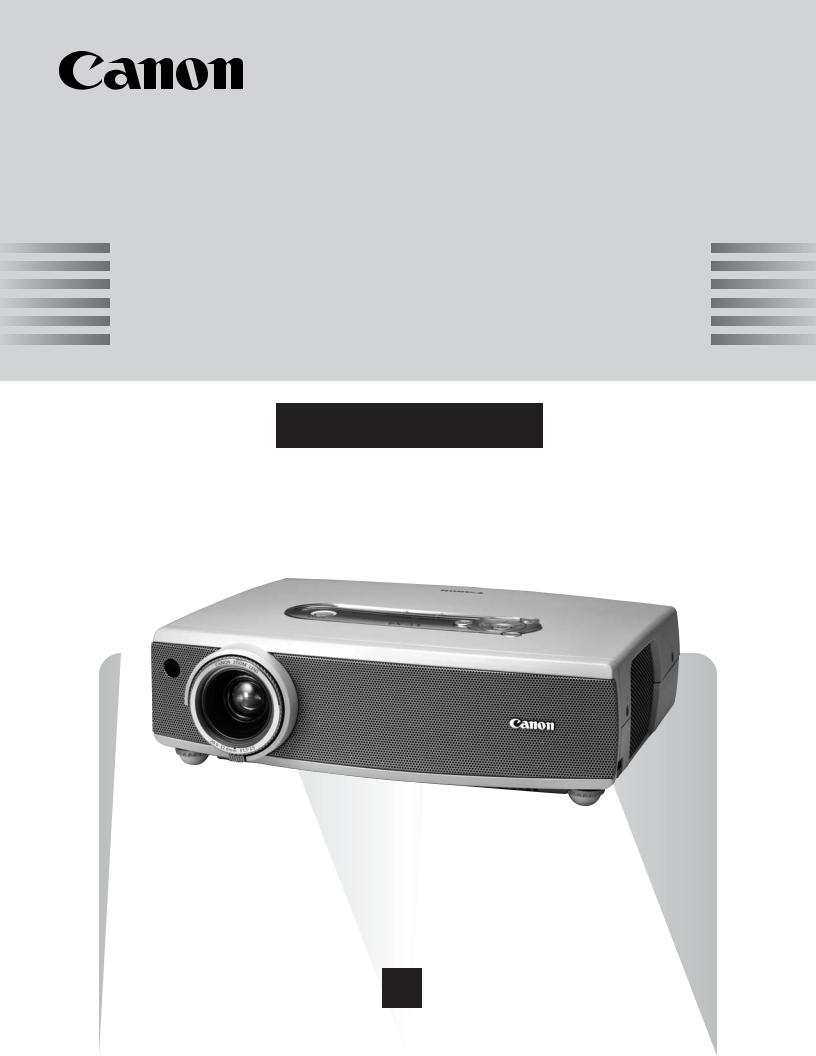
Multimedia Projector
LV-7225LV-7220LV-5220
Owner’s Manual
E
English

Features and Design
This Multimedia Projector is designed with the most advanced technology for portability, durability, and ease of use. This projector utilizes built-in multimedia features, a palette of 16.77 million colors, and matrix liquid crystal display (LCD) technology.
Wide Zoom Lens |
Selectable Lamp Mode |
||
|
|
|
|
This projector is equipped with Wide Zoom Lens which is 1.6 times the zoom ratio, and it allows you to enjoy 100" screen size in range of 8.2' (2.5m) to 13.1' (4m).
Compact Design
This projector is designed compact in size and weight. It is easy to carry and work anywhere you wish to use.
Brightness of the projection lamp can be selected in the Setting menu. (See page 45.)
Blackboard Function
Blackboard can be used as a projection screen.
The board color is limited to Green.
(See page 32 and 38.)
Compatibility
The projector widely accepts various video and computer input signals including; Computers, 6 Color systems, Component video, S-video and RGB scart.
Film Function
The Film function reproduces pictures faithful to the original film quality from 3:2 pull-down video contents.
(See page 40.)
Simple Computer System Setting
The projector has the Multi-scan system to conform to almost all computer output signals quickly. (See page 24, 28, and 42.)
PIN Code Lock Function
The PIN code lock function prevents others except users from using the projector. (See page 20 and 47.)
Digital Zoom (for Computer)
The digital zoom function expands (to approx. 16 times of screen size) or compress the image size, allowing you to focus on crucial information at a presentation. (See page 34.)
Multilanguage Menu Display
Operation menu is available in 12 languages; English, German, French, Italian, Spanish, Portuguese, Dutch, Swedish, Russian, Chinese, Korean, or Japanese. (See page 42.)
Power Management
The Power management function reduces power consumption and maintain the lamp life. (See page 45.)
Switchable Interface Terminal
The projector provides a switchable interface terminal. You can use the terminal as computer input or monitor output conveniently. (See page 44.)
User’s Logo
A projected image can be captured and used for the starting display of the projector with the Capture function. You can also display the captured image in an interval during your presentation instead of blackout image with the No show function. (See page 25 and 44.)
Auto Setup Function
For quick and easy setup of the projector, Auto Setup function is provided. Vertical auto keystone correction and Auto PC adjustment is performed with just pressing one button. (See page 24 and 42.)
2

Table of Contents
Features and Design . . . . . . . . . . . . . . . . . . .2
Table of Contents . . . . . . . . . . . . . . . . . . . . . .3
To the Owner . . . . . . . . . . . . . . . . . . . . . . . . .4
Safety Instructions . . . . . . . . . . . . . . . . . . . .5
Air Circulation |
6 |
Installing the Projector in Proper Position |
6 |
Moving the Projector |
6 |
Compliance . . . . . . . . . . . . . . . . . . . . . . . . . .7
Part Names and Functions . . . . . . . . . . . . . .8
Front |
8 |
Back |
8 |
Bottom |
8 |
Rear Terminal |
9 |
Top Control |
10 |
Remote Control Unit |
11 |
Laser Pointer Function |
12 |
Pointer Function |
12 |
Wireless Mouse Operation |
13 |
Operating Range |
13 |
Remote Control Code |
14 |
Remote Control Battery Installation |
14 |
Installation . . . . . . . . . . . . . . . . . . . . . . . . . .15
Positioning the Projector |
15 |
Adjustable Feet |
15 |
Connecting the AC Power Cord |
16 |
Connecting to a Computer |
17 |
Connecting to Video Equipment |
18 |
Connecting to Component Video Equipment |
19 |
Basic Operation . . . . . . . . . . . . . . . . . . . . . .20
Turning On the Projector |
20 |
Turning Off the Projector |
21 |
How to Operate the On-Screen Menu |
22 |
Menu Bar |
23 |
Zoom and Focus Adjustment |
24 |
Auto Setup Function |
24 |
Keystone Adjustment |
25 |
Picture Freeze Function |
25 |
No Show Function |
25 |
P-Timer Function |
26 |
Sound Adjustment |
26 |
Computer Input . . . . . . . . . . . . . . . . . . . . |
.27 |
Input Source Selection |
27 |
Computer System Selection |
28 |
Auto PC Adjustment |
29 |
Manual PC Adjustment |
30 |
Image Level Selection |
32 |
Image Level Adjustment |
33 |
Screen Size Adjustment |
34 |
Video Input . . . . . . . . . . . . . . . . . . . . . . . . . |
.35 |
Input Source Selection (Video, S-Video) |
35 |
Input Source Selection (Component, RGB Scart 21-Pin) |
|
|
36 |
Video System Selection |
37 |
Image Level Selection |
38 |
Image Level Adjustment |
39 |
Screen Size Adjustment |
41 |
Setting . . . . . . . . . . . . . . . . . . . . . . . . . . . . . |
42 |
Setting |
42 |
Maintenance and Cleaning . . . . . . . . . . . . . |
49 |
Warning Indicator |
49 |
Cleaning the Air Filters |
50 |
Attaching the Lens Cover |
50 |
Cleaning the Projection Lens |
51 |
Cleaning the Projector Cabinet |
51 |
Lamp Replacement |
52 |
Lamp Replace Counter |
53 |
Appendix . . . . . . . . . . . . . . . . . . . . . . . . . . . |
54 |
Troubleshooting |
54 |
Menu Tree |
56 |
Indicators and Projector Condition |
58 |
Compatible Computer Specifications |
59 |
Technical Specifications |
60 |
Optional Parts |
61 |
Configurations of Terminals |
62 |
Trademarks
Each name of corporations or products in this book is either a registered trademark or a trademark of its respective corporation.
3
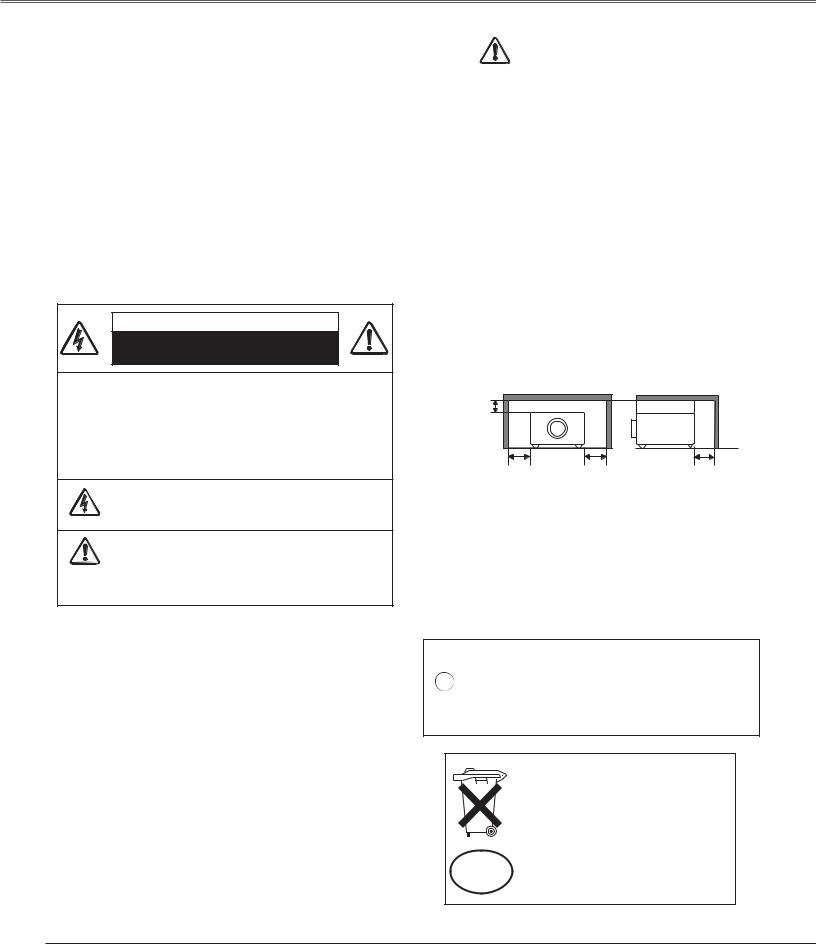
To the Owner
Before operating this projector, read this manual thoroughly and operate the projector properly.
This projector provides many convenient features and functions. Operating the projector properly enables you to manage those features and maintains it in better condition for a considerable time.
Improper operation may result in not only shortening the product-life, but also malfunctions, fire hazard, or other accidents.
If your projector seems to operate improperly, read this manual again, check operations and cable connections and try the solutions in the “Troubleshooting” section in the end of this booklet. If the problem still persists, contact the dealer where you purchased the projector or the service center.
CAUTION
RISK OF ELECTRIC SHOCK
DO NOT OPEN
CAUTION : TO REDUCE THE RISK OF ELECTRIC SHOCK, DO NOT REMOVE COVER (OR BACK). NO USER-SERVICEABLE PARTS INSIDE EXCEPT LAMP REPLACEMENT. REFER SERVICING TO QUALIFIED SERVICE PERSONNEL.
THIS SYMBOL INDICATES THAT DANGEROUS VOLTAGE CONSTITUTING A RISK OF ELECTRIC SHOCK IS PRESENT WITHIN THIS UNIT.
THIS SYMBOL INDICATES THAT THERE ARE IMPORTANT OPERATING AND MAINTENANCE INSTRUCTIONS IN THE OWNER'S MANUAL WITH THIS UNIT.
CAUTION
Not for use in a computer room as defined in the Standard for the Protection of Electronic Computer/Data Processing Equipment, ANSI/NFPA 75.
Ne puet être utillisé dans une salle d’ordinateurs telle que définie dans la norme ANSI/NFPA 75 Standard for Protection of Electronic Computer/Data Processing Equipment
Safety Precaution
WARNING : TO REDUCE THE RISK OF FIRE OR ELECTRIC SHOCK, DO NOT EXPOSE THIS APPLIANCE TO RAIN OR MOISTURE.
–This projector produces intense light from the projection lens. Do not stare directly into the lens as possible. Eye damage could result. Be especially careful that children do not stare directly into the beam.
–Install the projector in a proper position. If not, it may result in a fire hazard.
–Provide appropriate space on the top, sides and rear of the projector cabinet for allowing air circulation and cooling the projector. Minimum clearance must be maintained. If the projector is to be built into a compartment or similarly enclosed, the minimum distances must be maintained. Do not cover the ventilation slot on the projector. Heat buildup can reduce the service life of your projector, and can also be dangerous.
SIDE and TOP |
REAR |
3.3'(1m)
3.3'(1m) |
3.3'(1m) |
3.3'(1m) |
–Do not put any flammable object or spray can near the projector, hot air is exhausted from the ventilation holes.
–If the projector is not to be used for an extended time, unplug the projector from the power outlet.
READ AND KEEP THIS OWNER'S MANUAL FOR LATER USE.
NOTE FOR CUSTOMERS IN THE US
Hg LAMP(S) INSIDE THIS PRODUCT CONTAIN MERCURY AND MUST BE RECYCLED OR DISPOSED OF ACCORDING TO LOCAL, STATE OR FEDERAL LAWS.
For use in Netherlands
Bij dit produkt zijn batterijen geleverd.
Wanneer deze leeg zijn, moet u ze niet weggooien maar inleveren
NL als KCA.
4

Safety Instructions
All the safety and operating instructions should be read before the product is operated.
Read all of the instructions given here and retain them for later use. Unplug this projector from AC power supply before cleaning. Do not use liquid or aerosol cleaners. Use a damp cloth for cleaning.
Follow all warnings and instructions marked on the projector.
For added protection to the projector during a lightning storm, or when it is left unattended and unused for long periods of time, unplug it from the wall outlet. This will prevent damage due to lightning and power line surges.
Do not expose this unit to rain or use near water... for
example, in a wet basement, near a swimming pool, etc...
Do not use attachments not recommended by the manufacturer as they may cause hazards.
Do not place this projector on an unstable cart, stand, or table. The projector may fall, causing serious injury to a child or adult, and serious damage to the projector. Use only with a cart or stand recommended by the manufacturer, or sold with the projector. Wall or shelf mounting should follow the manufacturer's instructions, and should use a mounting kit approved by the manufacturers.
An appliance and cart combination should be moved with care. Quick stops, excessive force, and uneven surfaces may cause the appliance and cart combination to overturn.
Slots and openings in the back and bottom of the cabinet are provided for ventilation, to ensure reliable operation of the equipment and to protect it from overheating.
The openings should never be covered with cloth or other materials, and the bottom opening should not be blocked by placing the projector on a bed, sofa, rug, or other similar surface. This projector should never be placed near or over a radiator or heat register.
This projector should not be placed in a built-in installation such as a book case unless proper ventilation is provided.
Never push objects of any kind into this projector through cabinet slots as they may touch dangerous voltage points or short out parts that could result in a fire or electric shock. Never spill liquid of any kind on the projector.
Do not install the projector near the ventilation duct of airconditioning equipment.
This projector should be operated only from the type of power source indicated on the marking label. If you are not sure of the type of power supplied, consult your authorized dealer or local power company.
Do not overload wall outlets and extension cords as this can result in fire or electric shock. Do not allow anything to rest on the power cord. Do not locate this projector where the cord may be damaged by persons walking on it.
Do not attempt to service this projector yourself as opening or removing covers may expose you to dangerous voltage or other hazards. Refer all servicing to qualified service personnel.
Unplug this projector from wall outlet and refer servicing to qualified service personnel under the following conditions:
a.When the power cord or plug is damaged or frayed.
b.If liquid has been spilled into the projector.
c.If the projector has been exposed to rain or water.
d.If the projector does not operate normally by following the operating instructions. Adjust only those controls that are covered by the operating instructions as improper adjustment of other controls may result in damage and will often require extensive work by a qualified technician to restore the projector to normal operation.
e.If the projector has been dropped or the cabinet has been damaged.
f.When the projector exhibits a distinct change in performance-this indicates a need for service.
When replacement parts are required, be sure the service technician has used replacement parts specified by the manufacturer that have the same characteristics as the original part. Unauthorized substitutions may result in fire, electric shock, or injury to persons.
Upon completion of any service or repairs to this projector, ask the service technician to perform routine safety checks to determine that the projector is in safe operating condition.
Hinweise für Deutschland
Batterien und Akkumulatoren gehören nicht in den Hausmüll!
Im Interesse des Umweltschutzes sind Sie als Endverbraucher gesetzlich verpflichet (Batterieverordnung) alte und gebrauchte Batterien und Akkumulatoren zurückzugeben. Sie können die gebrauchten Batterien an den Sammelstellen der öffentlich-rechtlichen Entsorgungsträger in Ihrer Gemeinde oder überall dort abgeben, wo Batterien der betreffenden Art verkauft werden. Die Batterien werden unentgeltlich für den Verbraucher zurückgenommen.
5
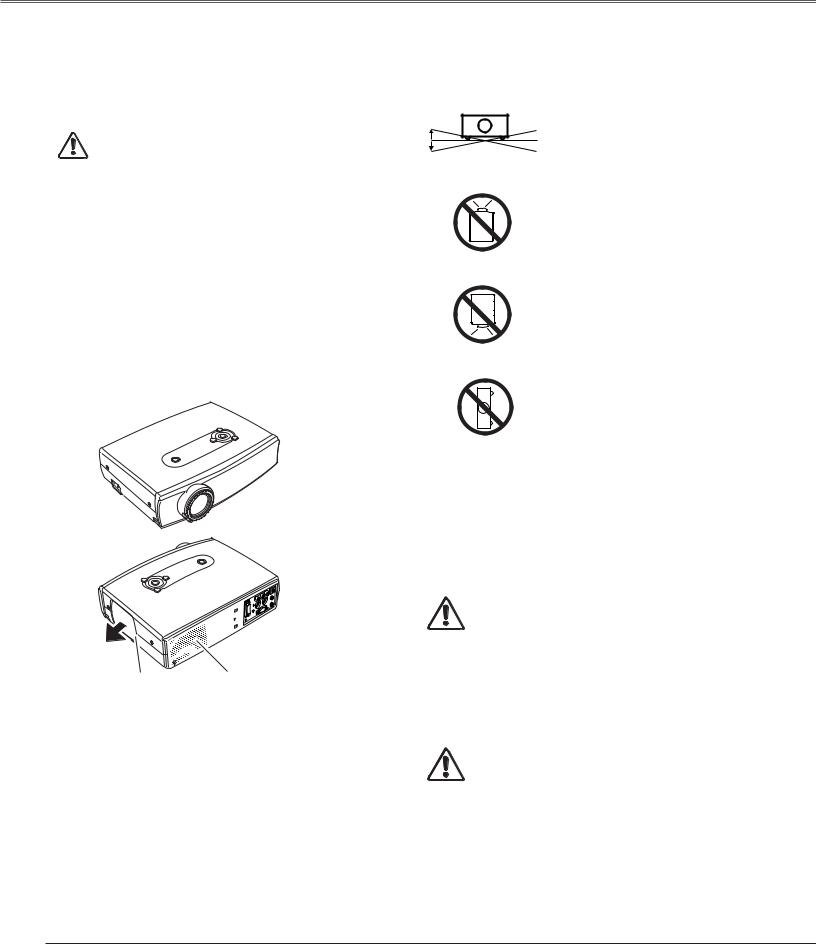
Safety Instructions
Air Circulation
Openings in the cabinet are provided for ventilation and to ensure reliable operation of the product and to protect it from overheating, and these openings must not be blocked or covered.
CAUTION
Hot air is exhausted from the exhaust vent. When using or installing the projector, the following precautions should be taken.
–Do not put any flammable objects near the vent.
–Keep the exhaust vent at least 3’(1m) away from any objects.
–Do not touch a peripheral part of the exhaust vent, especially screws and metallic part. This area will become hot while the projector is being used.
–Do not put anything on the cabinet. The materials put on the cabinet will not only get damaged but also cause fire hazard by heat.
Cooling fans are provided to cool down the projector. This projector monitors internal temperature and control the running speed of the cooling fans.
 Air Intake Vent
Air Intake Vent
Exhaust Vent |
Air Intake Vent |
(Hot air exhaust) |
|
Installing the Projector in Proper Position
Install the projector properly. Improper Installation may reduce
the lamp life and cause a fire hazard.
20˚
Do not tilt the projector more than 20 degrees above and below.
20˚
Do not point the projector up to
project an image.
Do not point the projector down to
project an image.
Do not put the projector on either
side to project an image.
Moving the Projector
When moving the projector, replace the Lens Cover and retract Adjustable Feet to prevent damage to the lens and cabinet.
When the projector is not in use for an extended period, put it into the case (carrying bag) supplied with the projector.
CAUTION
Carrying Bag (supplied) is intended for protection from dust and scratches on the surface of a cabinet, and it is not designed to protect an appliance from external forces. Do not transport a projector through a courier or transport services with this bag, otherwise the projector can be damaged. When handling a projector, do not drop, bump, subject it to strong forces or put other things on the cabinet.
USE CAUTION IN CARRYING OR
TRANSPORTING THE PROJECTOR
–Do not drop or bump a projector, otherwise damages or malfunctions may result.
–When carrying a projector, use a suitable carrying case.
–Do not transport a projector by using a courier or transport service in an unsuitable transport case. This may cause damage to a projector. To transport a projector through a courier or transport service, consult your dealer for their information.
6

Compliance
Federal Communication Commission Notice
Multimedia Projector, Model :LV-7225E,LV-7225U,LV-7220E,LV-7220U,LV-5220E and LV-5220U
This device complies with Part 15 of the FCC Rules. Operation is subject to the following two conditions:
(1)This device may not cause harmful interference, and
(2)this device must accept any interference received, including interference that may cause undesired operation.
Note : This equipment has been tested and found to comply with the limits for a Class B digital device, pursuant to part 15 of the FCC Rules. These limits are designed to provide reasonable protection against harmful interference in a residential installation. This equipment generates, uses and can radiate radio frequency energy and, if not installed and used in accordance with the instructions, may cause harmful interference to radio communications. However, there is no guarantee that interference will not occur in a particular installation. If this equipment does cause harmful interference to radio or television reception, which can be determined by turning the equipment off and on, the user is encouraged to try to correct the interference by one or more of the following measures :
–Reorient or relocate the receiving antenna.
–Increase the separation between the equipment and receiver.
–Connect the equipment into an outlet on a circuit different from that to which the receiver is connected.
–Consult the dealer or an experienced radio/TV technician for help.
Use of shielded cable is required to comply with class B limits in Subpart B of Part 15 of FCC Rules.
Do not make any changes or modifications to the equipment unless otherwise specified in the instructions. If such changes or modifications should be made, you could be required to stop operation of the equipment.
Canon U.S.A., Inc.
One Canon Plaza, Lake Success, NY 11042, U.S.A.
Tel No. (516)328-5600
Canadian Radio Interference Regulations
This Class B digital apparatus complies with Canadian ICE-003.
Réglementation canadienne sur les intérferences radio
Cet appareil numérique de la classe B est conforme à la norme NMB-003 du Canada. GROUND
For use in Germany
This product is intended for use in residential, commercial and light industry environment.
AC Power Cord Requirement
The AC Power Cord supplied with this projector meets the requirement for use in the country you purchased it.
AC Power Cord for the United States and Canada :
AC Power Cord used in the United States and Canada is listed by the Underwriters Laboratories (UL) and certified by the Canadian Standard Association (CSA).
AC Power Cord has a grounding-type AC line plug. This is a safety feature to be sure that the plug will fit into the
power outlet. Do not try to defeat this safety feature. Should you be unable to insert the plug into the outlet,
GROUND
contact your electrician.
THE SOCKET-OUTLET SHOULD BE INSTALLED NEAR THE EQUIPMENT AND EASILY ACCESSIBLE.
7
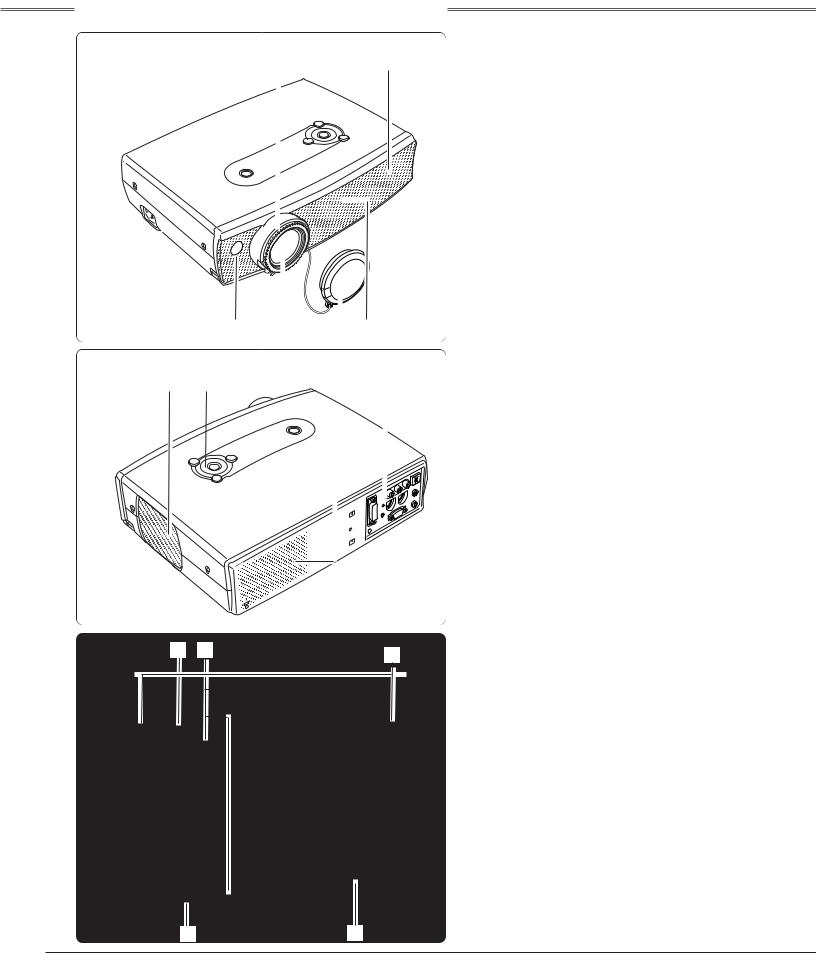
Part Names and Functions
Front |
q |
w |
e |
r t y |
|
u |
|
i |
|
||
Back |
|
|
|
|
|
|
|
|
|
|
|
|
|
|
|
||
!6 |
o |
|
!0 |
|
|
!1 |
||
|
|
|
|
|
|
|
|
|
Bottom |
!2 !3 |
!4 |
|
||
|
|
!2 |
!5 |
q Focus Ring w Speaker
e Power Cord Connector r Infrared Remote Receiver t Zoom Lever
y Projection Lens
u Lens Cover (See page 50 for attaching.) i Air Intake Vent
o Top Controls and Indicators
!0Air Intake Vent
!1Terminals and Connectors
!2Air Intake Vent (back and bottom)
!3Air Filter
!4Adjustable Feet
!5Lamp Cover
!6Exhaust Vent
 CAUTION
CAUTION
Hot air is exhausted from the exhaust vent. Do not put heat-sensitive objects near this side.
8
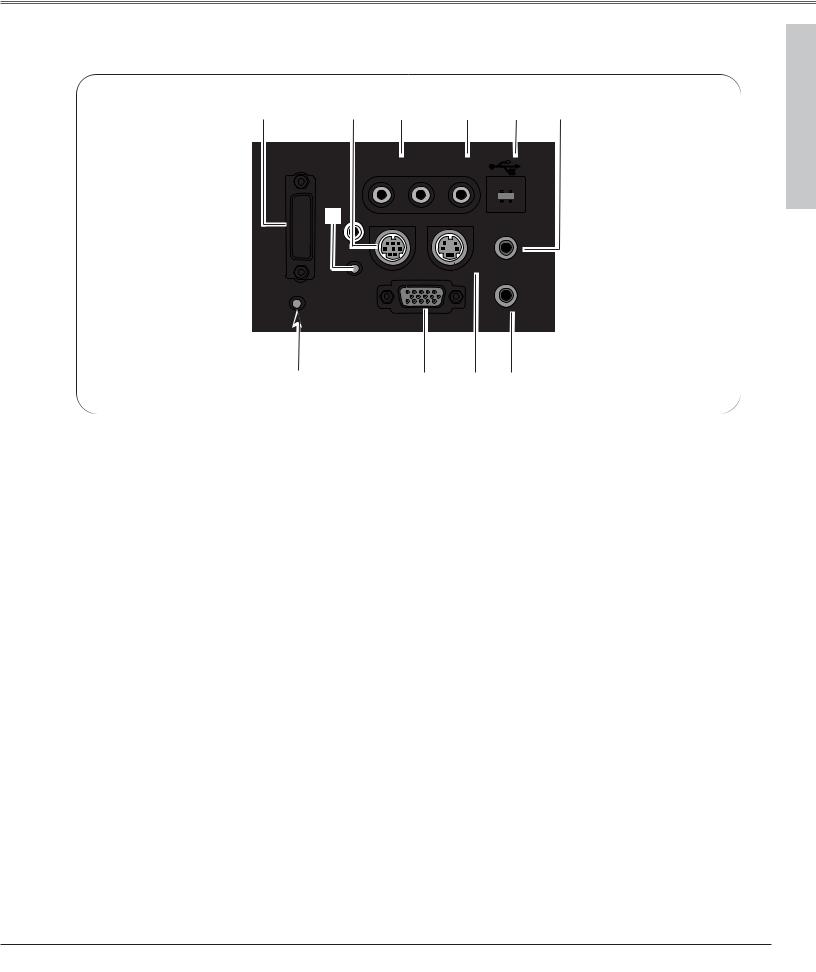
Part Names and Functions
Rear Terminal
q |
w |
e |
|
r |
t |
y |
DVI - I / |
|
AUDIO |
|
|
|
|
RGB IN-1 |
R |
IN |
L |
VIDEO IN |
|
|
|
|
|
||||
|
SERVICE PORT |
S-VIDEO IN |
COMPUTER |
|
||
|
|
|
|
|
AUDIO IN |
|
|
RESET |
|
|
|
|
|
 AUDIO OUT
AUDIO OUT
MCI |
RGB IN-2 / |
|
COMPONENT IN / |
|
RGB OUT |
Do not press this button. This button is used for optional |
|
o |
|
i |
|
u |
accessories. |
|
|
|
|
|
|
|
|
|
|
|
||
|
|
|
|
|
|
|
qDVI-I/ RGB IN-1
Connect output signal from a computer (Digital/Analog DVI-I type) or Multi Card Imager (optional) to this terminal. (p17)
wSERVICE PORT
This jack is used to service this projector.
eAUDIO IN
Connect the audio output from video equipment connected to r or i to this jack. (When the audio output is monaural, connect it to L (MONO) jack.) (p18)
rVIDEO IN
Connect the composite video output from video equipment to VIDEO jack. (p18)
tUSB (Series B)
When operating the connected computer with the remote control unit, connect USB port of your computer to this connector with a USB cable. (p17)
yCOMPUTER AUDIO IN
Connect the audio output (stereo) from a computer or video equipment connected to q or o to this jack.
(p 17, 19)
uAUDIO OUT
Connect an external audio amplifier to this jack.
(p1719)
This terminal outputs sound from AUDIO IN terminal (e or y).
iS-VIDEO IN
Connect the S-VIDEO output from video equipment to this jack. (p18)
oRGB IN-2/ COMPONENT IN/ RGB OUT
This terminal is switchable and can be used for input from a computer, video equipment (Component or RGB Scart) or output to the other monitor. Optional cables are required when using this terminal as component input or RGB Scart 21-Pin Video input. (p61)
Set the terminal up as either Computer input or Monitor output properly. (Used for Monitor out, this terminal outputs only incoming signal from DVI-I/ RGB IN-1 terminal.) (p17, 19, 44)
A built-in micro processor which controls this unit may occasionally malfunction and need to be reset. This can be done by pressing the RESET
button with a pen, which will shut down and restart the unit. Do not use the RESET function excessively.
Functions and Names Part
9
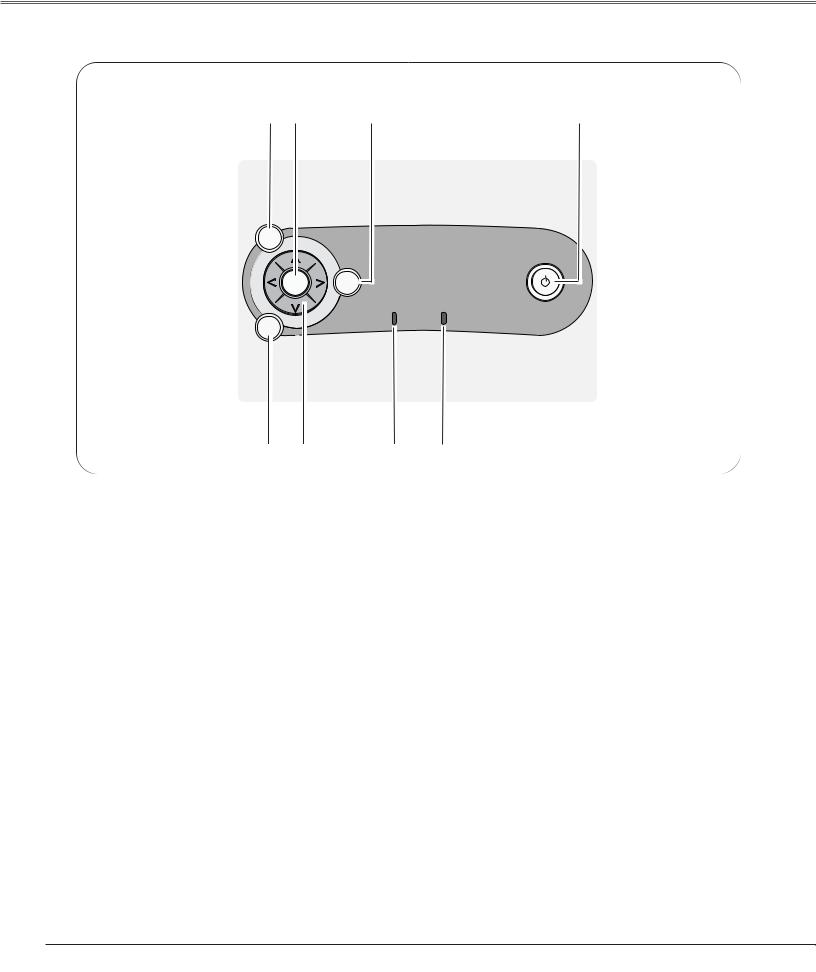
Part Names and Functions
Top Control
q w |
e |
r |
MENU |
|
|
|
|
|
|
POWER |
|
SET |
AUTO |
|
|
SET |
|
|
VOL |
|
|
|
|
VOL |
|
|
- |
|
+ |
|
|
|
LAMP REPLACE |
WARNING |
INPUT |
|
|
|
i u |
y |
t |
qMENU button
Opens or closes the On-Screen Menu. (p22)
wSET button
Executes the item selected. It is also used to expand/ compress the image in Digital zoom +/– mode. (p34)
eAUTO SET button
Corrects vertical keystone distortion and adjusts computer display parameters including Fine sync, Total dots and Picture position. (p24, 42)
rPOWER button
Turns the projector on or off. (p20, 21)
POWER indicator
Blinks red until the projector gets ready to be turned on. It turns red when the projector is in the stand-by mode. It remains green while the projector is under operation
tWARNING indicator
Lights red when the projector detects abnormal condition. This also blinks red when the internal temperature of the projector exceeds the operating range. (p49)
yLAMP REPLACE indicator
Turns yellow when the life of the projection lamp draws to an end. (p52)
uPOINT (ed78 ) (VOL+/–) button
Selects an item or adjusts value in the On-Screen Menu. These are also used to pan the image in the Digital zoom +/– mode. (p34)
Point 78 button are used as VOL +/– button. (p26)
i INPUT button
Selects input source. (p27, 35, 36 )
10

Part Names and Functions
Remote Control Unit
q 
w |
|
|
e |
!5 |
|
r |
||
|
||
t |
!6 |
|
y |
|
|
u |
|
i |
|
o |
!7 |
!0 |
!8 |
!1 |
!9 |
|
!2 |
||
@0 |
||
!3 |
||
@1 |
||
!4 |
||
@2 |
||
|
qL-CLICK button
Acts as left click for wireless mouse operation. (p13)
wSIGNAL EMISSION indicator
This indicator lights red while the laser beam is being emitted from the laser light window or a signal is being sent from the remote control unit to the projector.
eKEYSTONE button
Corrects keystone distortion. (p25, 42)
rAUTO PC button
Operates the Auto PC adjustment function. (p29)
tAUTO SET button
Corrects vertical keystone distortion and adjusts PC display parameters. (p24, 42)
yCOMPUTER button
Selects input source (COMPUTER 1 or COMPUTER 2). (p27)
uPOINT (ed78) button
Selects an item or adjusts value in the On-Screen Menu. These are also used to pan the image in the Digital zoom +/- mode. (p34)
Point 78 button are also used as VOL+/- buttons. (p26)
i PRESENTATION POINTER button
Move a pointer of the projector or a pointer for wireless mouse operation. (p12)
oSET button
Executes the item selected, or to expand or compress image in the Digital zoom +/- mode. (p34)
!0PAGE UP/DOWN button
Turns pages; the Up button to the previous page and the Down button to the next page for an image from a computer. Connect the projector and your computer with a USB cable before use. (See page 17.)
!1LASER button
Operates the Laser pointer function. Laser beam is emitted while pressing this button within 1 minute. When using this laser pointer for more than 1 minute, release the LASER button and press it again. This button is also used as a switching button to activate the Pointer function of the projector. (p12,13)
!2FREEZE button
Freezes the projected picture. (p25)
!3IMAGE button
Selects image levels.(p32, 38)
!4MUTE button
Mutes sound. (p26)
!5POWER button
Turns the projector on or off. (p20, 21)
!6VIDEO button
Selects input source (VIDEO). (p35)
!7MENU button
Opens or closes the On-Screen Menu. (p22)
!8D.ZOOM button
Selects the Digital zoom +/– mode and resize the image. (p34)
!9NO SHOW button
Turns the picture into black image. (p25)
@0R-CLICK button
Acts as right click for wireless mouse operation. (p13)
@1P-TIMER button
Operates P-Timer function. (p26)
@2RESET/ON/ALL-OFF switch
When using the remote control unit, set this switch to “ON.” Set it to “ALL OFF” for power saving when it is not used. Slide this switch to "RESET" to initialize the remote control code or switch Spotlight and Pointer back to Laser pointer. (p12, 14)
Functions and Names Part
11
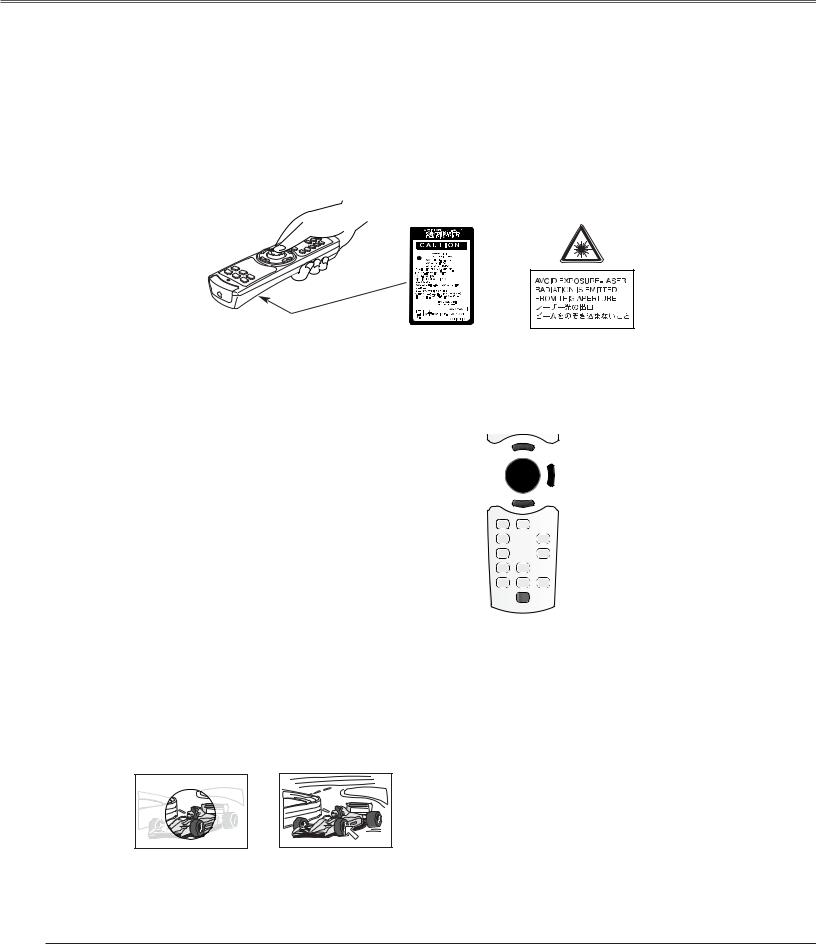
Part Names and Functions
Laser Pointer Function
This remote control unit emits a laser beam from the laser light window. With the LASER button pressed, laser light goes on. The signal emission indicator lights red and laser is emitted with red light. With the LASER button pressed for more than 1 minute or released, the light goes off.
The laser emitted is a class II laser. Do not look into the laser light window or shine the laser beam on yourself or other people. Below are the caution labels for laser beam.
CAUTION : Use of controls, adjustments or performance of procedures other than those specified herein may result in hazardous radiation exposure. Do not look into the laser light window while laser is emitted, otherwise eye damage may result.
These caution labels are put on the remote control unit.
Signal Emission Indicator
Laser Light Window
Pointer Function
You can move Spotlight or Pointer of the projector with the remote control unit to emphasize a part of the projected image.
1 |
With pressing the MENU button, hold down the NO SHOW |
|
button for more than 7 seconds so that the Pointer function |
|
will be available. (The Laser pointer has switched to the |
|
Pointer.) |
2 |
Press the LASER button on the remote control unit toward |
|
the projector. Spotlight or Pointer is displayed on the screen |
|
with the LASER button lighting green. Then move the |
|
Spotlight or Pointer with the PRESENTATION POINTER |
|
button. If the LASER button does not light green and still |
|
emits laser beam, try the procedure above until the LASER |
|
button lights green. |
3 |
To clear the Spotlight or Pointer out the screen, press the |
LASER button toward the projector and see if the LASER button lighting turns off.
To switch back to the Laser pointer again, hold down the NO SHOW button with pressing the MENU button for more than 7 seconds or slide the RESET/ON/ALL-OFF switch to "RESET". (p11)
Spotlight |
Pointer |
While pressing the MENU button, hold down the NO SHOW button for more than 7 seconds.


 PRESENTATION POINTER button
PRESENTATION POINTER button

 MENU button
MENU button

 NO SHOW button
NO SHOW button


 PRESENTATION POINTER button
PRESENTATION POINTER button

 LASER button
LASER button
After the Laser pointer has switched to the Pointer, use the LASER button as the Pointer function ON-OFF switch. Press the LASER button toward the projector and see if it lights green.
Note:
You can choose the size of Spotlight (Large, Middle, and Small) and the pattern of Pointer (Arrow, Finger, and Dot) in the Setting Menu. See “Pointer” on page 46.
12
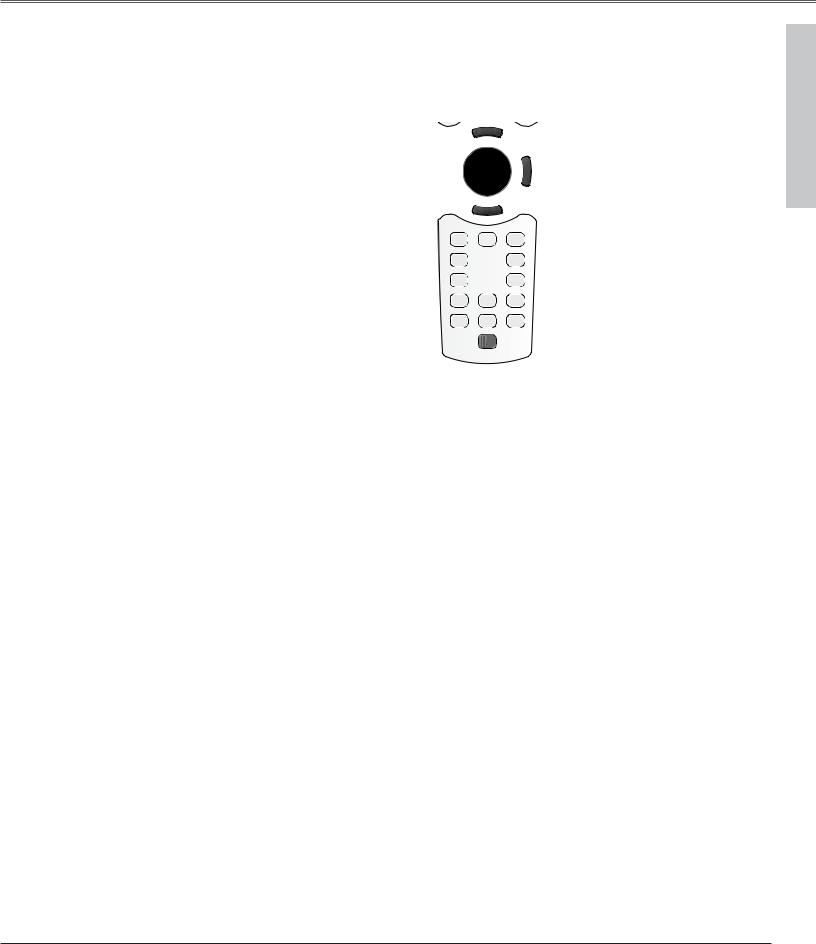
Part Names and Functions
Wireless Mouse Operation
The remote control unit can be used as a wireless mouse for your computer. Before operating the wireless mouse, connect your computer and the projector with the supplied USB cable. (See page 17 for connection.)
When the Pointer function is used, the wireless mouse is not available.
PRESENTATION POINTER button
Move the pointer on the screen with this button.
L-CLICK button
Acts as left click while the projector and a computer are connected with a USB cable.
Functions and Names Part
Operating Range
Point the remote control unit toward the projector (Infrared Remote Receiver) whenever pressing any button. Maximum operating range for the remote control unit is about 16.4’ (5m) and 60° in front of the projector.
16.4’ (5 m)
60°
Remote control unit
13
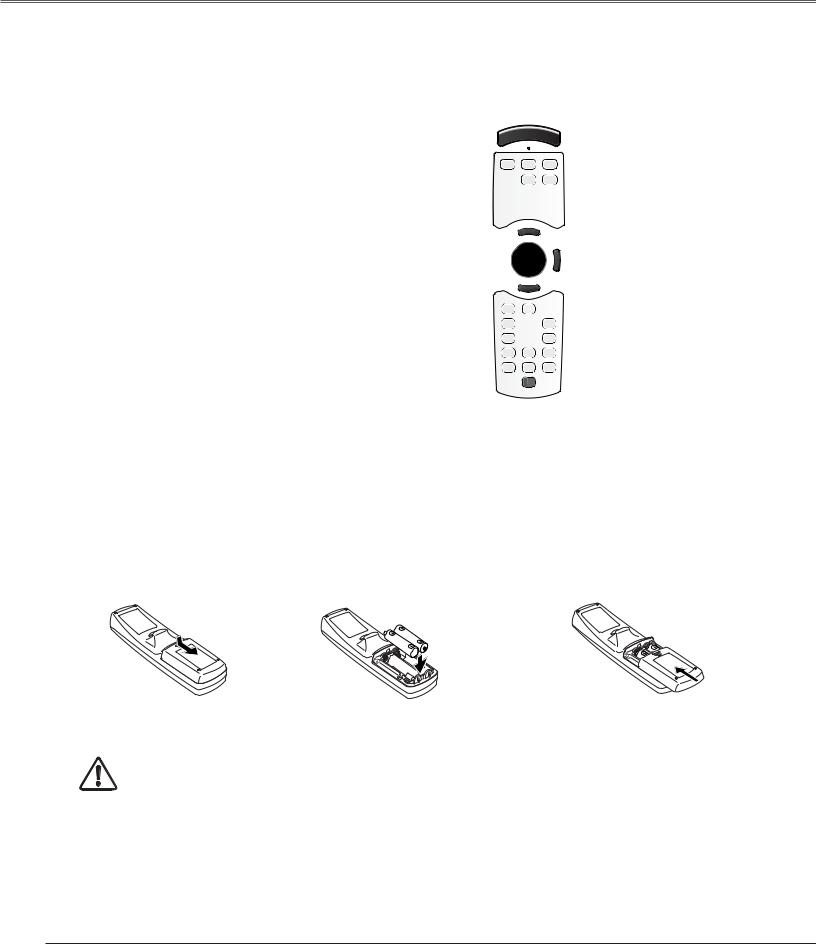
Part Names and Functions
Remote Control Code
This projector has eight different remote control codes (Code 1-Code 8). Switching remote control codes prevents remote control interference when operating several projectors or video equipment at the same time. Change the remote control code for the projector first before changing that for the remote control unit. See “Remote control” in Setting on page 46.
1 |
With holding down the MENU button, press the IMAGE |
|||
|
button. The code switches sequentially for one pressing the |
|||
|
IMAGE button. (See the list below.) |
|||
2 |
To initialize the |
remote control code, slide the |
||
|
RESET/ON/ALL-OFF switch to RESET, and then to ON. The |
|||
|
initial code is Code 1. (p11) |
|||
|
|
|
|
|
|
Remote Control Code |
|
Number of Times of |
|
|
|
Pressing IMAGE Button |
|
|
|
|
|
|
|
|
|
|
|
|
|
Code 1 |
|
1 |
|
|
|
|
|
|
|
Code 2 |
|
2 |
|
|
|
|
|
|
|
Code 3 |
|
3 |
|
|
|
|
|
|
|
Code 4 |
|
4 |
|
|
|
|
|
|
|
Code 5 |
|
5 |
|
|
|
|
|
|
|
Code 6 |
|
6 |
|
|
|
|
|
|
|
Code 7 |
|
7 |
|
|
|
|
|
|
|
Code 8 |
|
8 |
|
|
|
|
|
|
While pressing the MENU button, press the IMAGE button number of times corresponding to the remote control code.

 MENU button
MENU button
IMAGE button
Remote Control Battery Installation
1 |
Remove the battery |
compartment lid. |
Press the lid downward and slide it.
2 |
Slide the batteries into |
3 |
Replace the compartment |
the compartment. |
lid. |
Two AA size batteries
For correct polarity (+ and
–), be sure battery terminals are in contact with pins in compartment.
To insure safe operation, please observe the following precautions :
●Use (2) AA, UM3 or LR6 type alkaline batteries.
●Replace two batteries at the same time.
●Do not use a new battery with a used battery.
●Avoid contact with water or liquid.
●Do not expose the remote control unit to moisture, or heat.
●Do not drop the remote control unit.
●If a battery has leaked on remote control unit, carefully wipe case clean and install new batteries.
●Risk of explosion if battery is replaced by an incorrect type.
●Dispose of used batteries according to the instructions.
14

Installation
Positioning the Projector
This projector is designed to project on a flat projection surface and can be focused from 3.3’(1.0m) - 25.3’(7.7m). Refer to the figure and the table below for the screen size and the distance between the projector and the screen.
A : B = 9 : 1
25.3' (7.7m)
(Inch Diagonal)
|
|
16.1' (4.9m) |
|
300” |
|
|
|
|
|
||
|
12.5' (3.8m) |
|
|
Max. Zoom |
|
|
|
|
|
||
|
8.2' (2.5m) |
190” |
|
190” |
|
|
|
|
|||
|
3.3' (1.0m) |
|
150” |
|
A |
|
|
122” |
|
Min. Zoom |
|
|
|
100” |
|
||
|
|
|
|
||
|
|
95” |
|
|
|
|
|
|
|
|
|
|
40” |
62” |
|
|
|
|
|
|
|
|
|
|
|
|
|
|
(Center) |
|
|
|
|
|
B |
Screen Size |
40” |
100” |
150” |
190” |
300” |
(W x H) mm |
813 x 610 |
2032 x 1524 |
3048 x 2286 |
3861 x 2896 |
6096 x 4572 |
4 : 3 aspect ratio |
|||||
Zoom (min) |
5.2' (1.6m) |
13.1' (4.0m) |
19.7 (6.0m) |
25.3' (7.7m) |
––-–– |
Zoom (max) |
3.3' (1.0m) |
8.2' (2.5m) |
12.5' (3.8m) |
16.1' (4.9m) |
25.3' (7.7m) |
Note:
•The brightness in a room has a great influence on picture quality. It is recommended to limit ambient lighting in order to obtain the best image.
•The values shown above are approximate and may vary from the actual size.
Adjustable Feet
Projection angle can be adjusted up to 11.9 degrees with the adjustable feet.
1 |
Lift the front of the projector and pull upward the feet lock |
|
latches on both sides of the projector. |
2 |
Release the feet lock latches to lock the adjustable feet and |
|
rotate the adjustable feet to adjust the position and tilt. |
3 |
To retract the adjustable feet, lift the front of the projector |
and pull and undo the feet lock latches.
Keystone distortion of the projected image can be adjusted automatically with Auto Setup function or manually with the remote control unit or the menu operation. (p24, 25, and 42)
Feet Lock Latches
Adjustable Feet
Installation
15

Installation
Connecting the AC Power Cord
This projector uses nominal input voltages of 100-120 V or 200-240 V AC. This projector automatically selects the correct input voltage. It is designed to work with single-phase power systems having a grounded neutral conductor. To reduce risk of electrical shock, do not plug into any other type of power system.
Consult your authorized dealer or service station if you are not sure of the type of power being supplied.
Connect the projector with all peripheral equipment before turning the projector on. (See page 17-19 for connection.)
CAUTION
For safety, unplug AC power cord when the projector is not in use. When this projector is connected to an outlet with AC power cord, it is in Stand-by mode and consumes a little electric power.
Connect AC power cord (supplied) to the projector.
The AC outlet must be near this equipment and must be easily accessible.
NOTE ON THE POWER CORD
AC power cord must meet requirement of the country where you use a projector. Confirm an AC plug type with the chart below and proper AC power cord must be used. If supplied AC power cord does not match your AC outlet, contact your sales dealer.
Projector side |
AC outlet side |
||
|
For the U.S.A. and Canada |
For Continental Europe |
|
|
Ground |
|
|
To power cord |
To the AC outlet. |
To the AC outlet. |
|
connector on your |
|||
(120 V AC) |
|||
projector. |
(200 - 240 V AC) |
||
|
|||
16
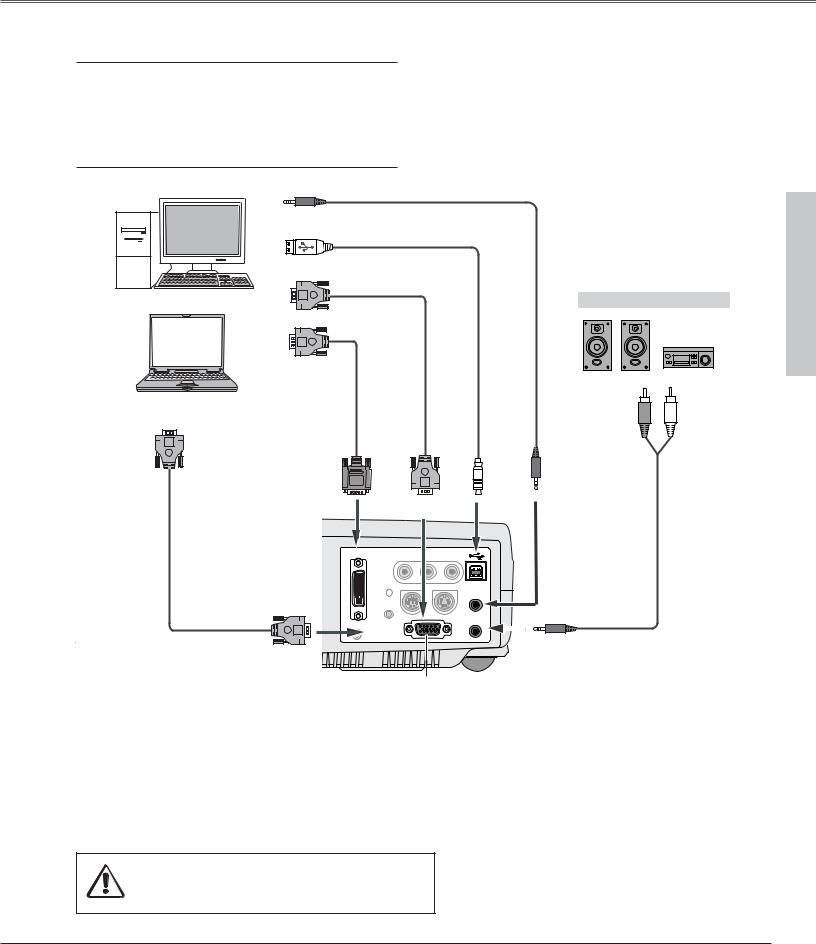
Installation
Connecting to a Computer
Cables used for connection
•VGA Cable (HDB 15 pin)
•DVI-VGA Cable (HDB 15 pin)
•USB Cable
•Audio Cables (Mini Plug: stereo) ( = Not supplied with this projector.)
Audio Output
USB port
Audio cable (stereo)
USB cable
External Audio Equipment
VGA cable
Monitor Output |
Monitor Output |
Audio Input
DVI-VGA cable
Monitor Input
DVI-I / RGB IN-1 |
COMPUTER IN-2/ COMPONENT |
USB |
||||
|
IN/ MONITOR OUT |
|
|
|
||
DVI-I/ |
|
AUDIO |
|
|
|
|
RGB IN-1 |
R |
IN |
L |
VIDEO IN |
|
|
|
SERVICE PORT |
|
S-VIDEO IN |
COMPUTER |
||
|
|
|
|
|
AUDIO IN |
|
VGA cable |
RESET |
|
|
|
|
|
|
|
|
|
AUDIO OUT |
||
|
|
|
|
|
||
MCI |
RGB IN-2/ |
|
|
|
|
|
|
COMPONENT IN/ |
|
|
|
|
|
|
RGB OUT |
|
|
|
|
|
RGB IN-2/ COMPONENT IN/
MONITOR OUT
This terminal is switchable. Set up the terminal as either Computer input or Monitor output. (See Page 44.)
Note:
•When connecting AUDIO OUT to external audio equipment, the projector's built-in speaker is disconnected.
Note:
When connecting the cable, the power cords of both the projector and the external equipment should be disconnected from AC outlet.
COMPUTER AUDIO IN
AUDIO OUT (stereo)
Audio cable (stereo)
Installation
17
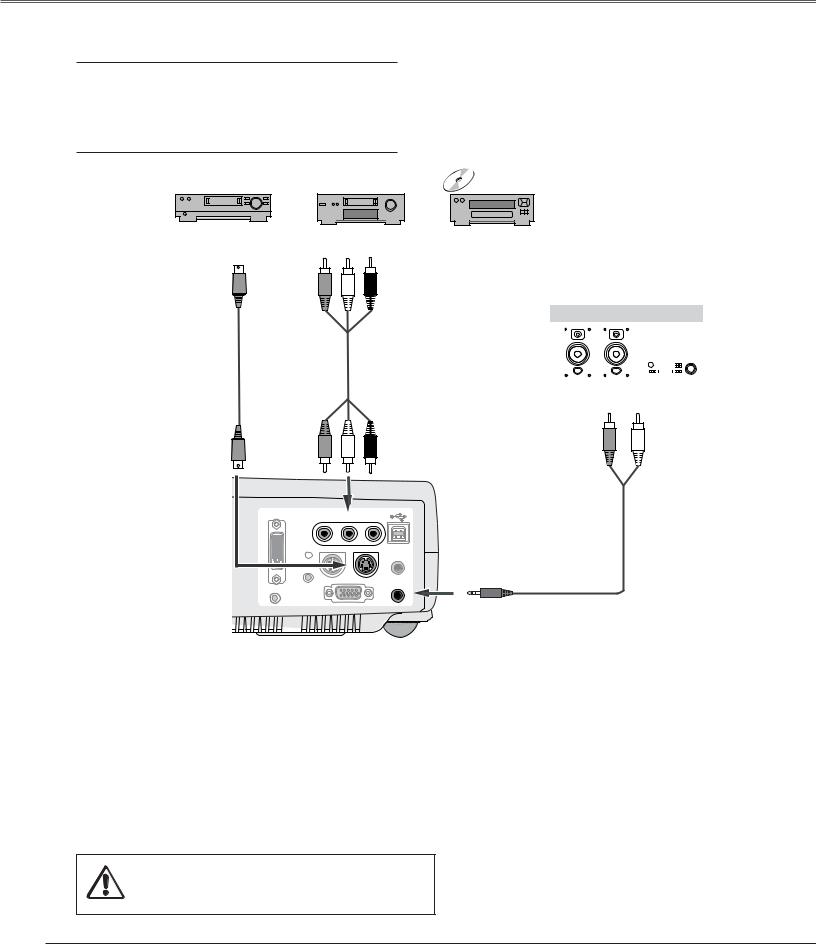
Installation
Connecting to Video Equipment
Cables used for connection
•Video and Audio Cable (RCA x 3)
•S-VIDEO Cable
•Audio Cables (Mini Plug: stereo)
( = Not supplied with this projector.)
S-Video Output |
Composite Video and |
||
|
Audio Output |
|
|
|
|
|
|
|
(R) |
(L) |
(Video) |
External Audio Equipment
S-Video cable |
Video and audio |
|
|
|
|
|
|
|
|
cable |
|
|
|
|
|
|
|
|
|
|
|
|
|
|
|
|
|
||
|
|
|
|
|
|
|
|
|
|
|
|
|
|
|
|
|
|
|
|
Audio Input
S-VIDEO IN |
AUDIO IN |
(R) |
(L) |
|
|
VIDEO IN |
|
DVI-I/ |
|
AUDIO |
|
|
|
|
RGB IN-1 |
R |
IN |
L |
VIDEO IN |
|
|
|
|||||
|
|
SERVICE PORT |
|
S-VIDEO IN |
COMPUTER |
|
|
|
|
|
|
|
AUDIO IN |
|
RESET |
|
|
|
|
|
AUDIO OUT
MCI |
RGB IN-2/ |
|
COMPONENT IN/ |
|
RGB OUT |
AUDIO OUT (stereo)
Note:
•The S-VIDEO jack has priority over the VIDEO jack under the condition of connecting both the S-VIDEO jack and the VIDEO jack when selecting AUTO in the Input Menu.
•Input sound to the COMPUTER AUDIO IN terminal when using the RGB IN-2/COMPONENT IN/ RGB OUT terminal as input.
•When connecting AUDIO OUT to external audio equipment, the projector's built-in speaker is disconnected.
Note:
When connecting the cable, the power cords of both the projector and the external equipment should be disconnected from AC outlet.
Audio cable (stereo)
18
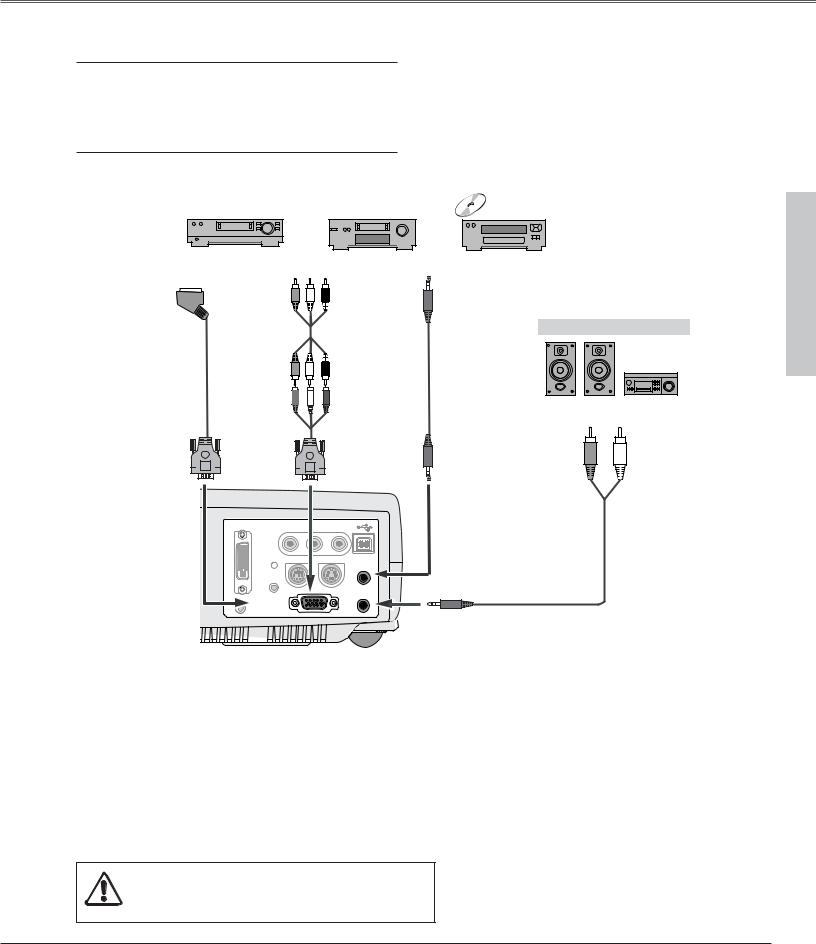
Installation
Connecting to Component Video Equipment
Cables used for connection
•Audio Cables (Mini Plug (stereo) x 2 or RCA x 2) , (RCA x 3)
•Scart-VGA Cable
•Component-VGA Cable (Separately supplied as LV-CA32)
( = Not supplied with this projector.)
RGB Scart 21-pin Output |
Component Video Output |
Audio Output |
Installation |
|
|||
(Y, Pb/Cb, Pr/Cr) |
|
||
|
|
|
|
|
Video and audio |
External Audio Equipment |
|
|
cable |
|
|
|
|
|
|
Scart-VGA cable |
|
Audio cable |
|
|
|
(stereo) |
|
|
Component-VGA |
Audio Input |
|
|
cable |
|
|
RGB IN-2/ COMPONENT IN/ RGB OUT
RGB IN-2/ |
COMPUTER AUDIO IN |
COMPONENT IN/ |
|
RGB OUT |
|
DVI-I/ |
|
AUDIO |
|
|
|
RGB IN-1 |
R |
IN |
L |
VIDEO IN |
|
|
SERVICE PORT |
|
S-VIDEO IN |
COMPUTER |
|
|
|
|
|
|
AUDIO |
|
RESET |
|
|
|
|
|
|
|
|
|
AUDIO |
|
RGB IN-2/ |
|
|
|
|
|
COMPONENT IN/ |
|
|
|
|
|
RGB OUT |
|
|
|
|
AUDIO OUT (stereo)
Audio cable (stereo)
Note:
•Input sound to the COMPUTER AUDIO IN terminal when using the RGB IN-2/ COMPONENT IN/ RGB OUT terminal as input.
•When connecting AUDIO OUT to external audio equipment, the projector's built-in speaker is disconnected.
Note:
When connecting the cable, the power cords of both the projector and the external equipment should be disconnected from AC outlet.
19
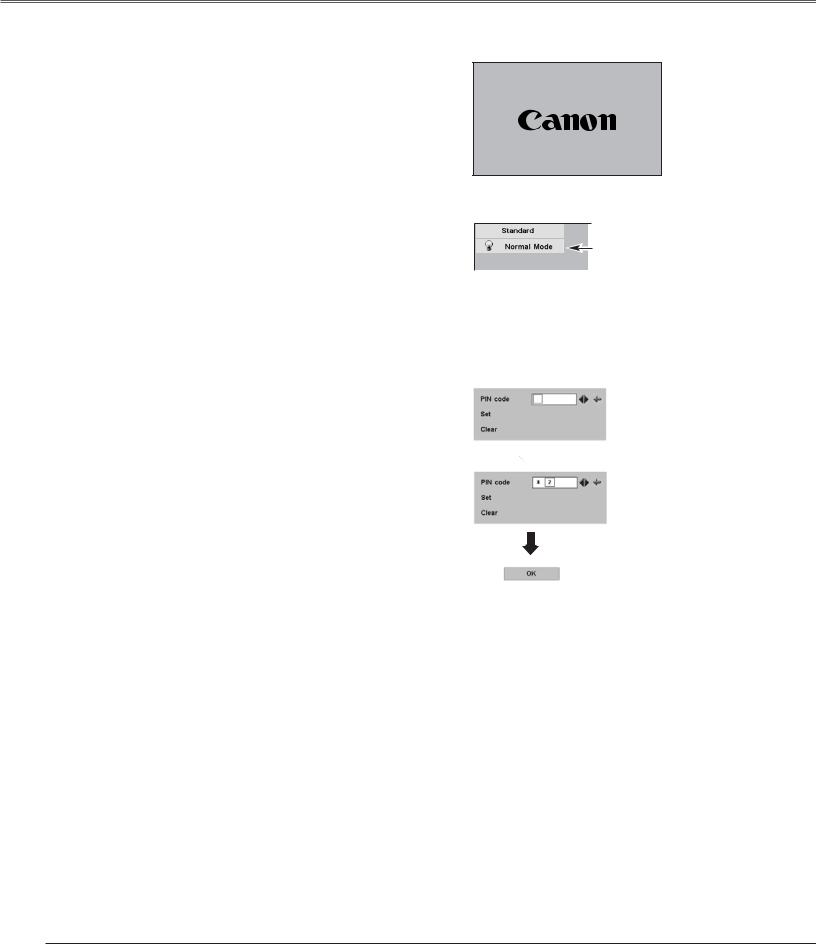
Basic Operation
Turning On the Projector
1 |
Complete peripheral connections (with a computer, VCR, |
|
etc.) before turning on the projector. |
2 |
Connect the projector's AC power cord into an AC outlet. |
|
The POWER indicator blinks red in a moment and lights red. |
3 |
Press the POWER button on the top control or on the |
|
remote control unit. The POWER indicator turns green |
|
lighting and the cooling fans start to operate. The |
|
preparation display appears on the screen and the count |
|
down starts. |
4 |
After the count-down, the image level that was selected last |
|
and the Lamp mode status icon (see page 45) appear on the |
screen.
Note:
If the projector is locked with a PIN code, PIN code Input Dialog Box will appear. Enter the PIN code as instructed below.
Enter a PIN code
Select a number by pressing the Point 78 button and fix the number with the SET button. The number will change to " ". If you fixed a wrong number, move the pointer to "Set" or "Clear" once by pressing the Point d button, then return to "PIN code". Enter the correct number again.
Repeat this step to complete entering a four-digit number.
When the four-digit number is fixed, the pointer will automatically move to "Set". Press the SET button so that you can start to operate the projector.
If you entered a wrong PIN code, "PIN code" and the number ( ) will turn red and disappear. Enter a correct PIN code all over again.
What is PIN code?
PIN code is a security code using Personal Identification Number that allows the person who knows it to operate the projector. Setting PIN code prevents others except the specific users from operating the projector.
A PIN code consists of a four-digit number. Refer to PIN code lock function in Setting on page 47 for locking operation of the projector with your PIN code.
16
The preparation display disappears after 30 seconds.
Selected Image Level and Lamp Mode
Lamp mode
(See page 45 for Lamp mode.)
PIN code Input Dialog Box
 Pointer
Pointer
After the OK icon disappears, you can operate the projector.
20
